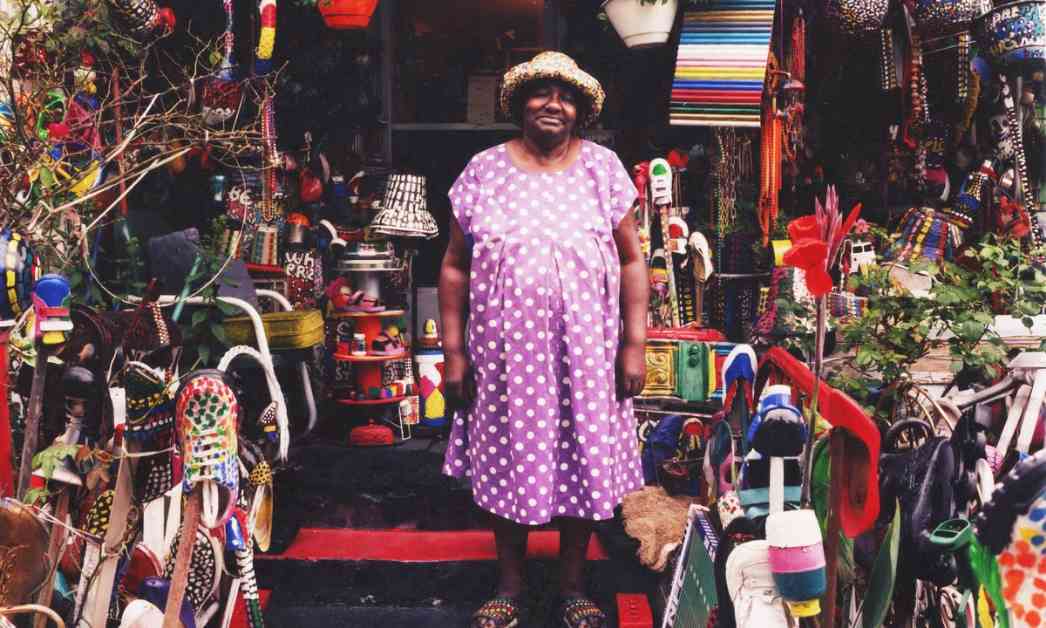Preserving the Legacy of L.V. Hull: A Landmark Achievement in African American Art History
In a groundbreaking move that highlights the importance of African American artists in American cultural heritage, the home-studio of the late artist L.V. Hull has been added to the US National Register of Historic Places. Located in Kosciusko, Mississippi, Hull’s home is now officially recognized as a significant art environment created by an African American artist, marking a historic moment in the preservation of Black artistic contributions.
Hull’s artistic journey began in 1974 when she purchased her house in Kosciusko and embarked on a transformative project to turn it into a vibrant art space. Using found objects and everyday materials, Hull adorned her home with a colorful array of creations, from polka-dotted hubcaps to shoes arranged like flowers on poles. Handmade signs bearing messages of inspiration and reflection were interspersed among the eclectic collection of objects that filled both the interior and exterior of her home.
Yaphet Smith, a local resident whose grandmother lived near Hull’s house, had been a frequent visitor to the artist’s unique home-studio for years. After Hull’s passing in 2008, the future of the site became uncertain until Smith took action. In 2021, he purchased the long-unoccupied building with plans to preserve its legacy through his non-profit organization, the Keysmith Foundation. The addition of Hull’s home to the National Register of Historic Places is a significant step towards ensuring its continued existence as part of the planned L.V. Hull Legacy Center, set to open in 2025 as the county’s first visual arts facility.
Championing Diversity in American Creativity
The recognition of Hull’s home-studio on the National Register of Historic Places is not only a tribute to her artistic legacy but also a milestone in the broader narrative of American creativity. Yaphet Smith, who is spearheading efforts to honor Hull’s memory, emphasizes the importance of accurately documenting the diverse stories of creativity in America. By including Hull’s home on the National Register, Smith hopes to inspire the preservation of other spaces and stories of African American artists, particularly women whose contributions have often been overlooked.
The L.V. Hull Legacy Center, which will house Hull’s preserved home-studio, serves as a testament to the historic significance of her artistic vision. Chris Morris, a senior director at the National Trust for Historic Preservation, acknowledges the transformative impact of designating Hull’s home as a nationally recognized historic site. This decision challenges traditional preservation practices that have historically favored the work of white or male artists and architects, highlighting the importance of recognizing the contributions of women, people of color, and Indigenous artists in shaping American cultural heritage.
Securing the Future of Hull’s Artistic Legacy
In addition to the symbolic significance of Hull’s home-studio being added to the National Register, the designation opens up new opportunities for funding and support for the site. These resources are crucial for the successful establishment of the L.V. Hull Legacy Center, which aims to celebrate her artistic legacy and provide a space for future generations to engage with her work. The Legacy Center will play a pivotal role in preserving Hull’s unique artistic vision and ensuring that her contributions to American art history are recognized and celebrated.
One of the key challenges in preserving Hull’s artistic legacy has been the historical exploitation of Southern artists by outside collectors and institutions. Annalise Flynn, an independent curator involved in advocating for Hull’s site, highlights the importance of keeping her art within the local community to prevent it from being removed and dispersed to distant locations. The efforts of organizations like the Kohler Foundation, which conserved and donated a significant collection of Hull’s artwork to the Arts Foundation of Kosciusko, are essential in safeguarding her artistic legacy for future generations.
While none of Hull’s art is currently installed in her home-studio, plans are underway to showcase her work as part of the Legacy Center’s exhibitions. The Mississippi Museum of Art is also set to host an exhibition of Hull’s artwork next year, providing a platform for her unique artistic vision to reach a wider audience. Yaphet Smith reflects on the enduring presence of Hull’s imagination in her home, noting the faded spots on the walls where her art once hung and the nails that still adorn the space, serving as a poignant reminder of her creative spirit.
As efforts to preserve and celebrate the legacy of L.V. Hull continue, the addition of her home-studio to the National Register of Historic Places stands as a testament to the enduring impact of African American artists on American cultural heritage. Through the establishment of the L.V. Hull Legacy Center and ongoing initiatives to showcase her artwork, Hull’s artistic vision will live on as a source of inspiration and reflection for generations to come.
